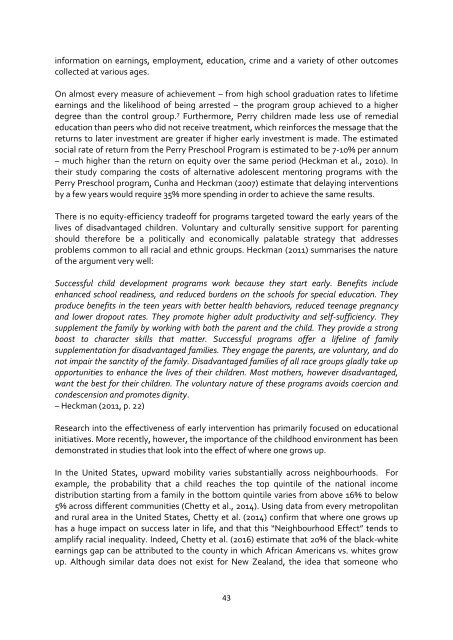UNCONSCIOUS BIAS AND EDUCATION
unconsious-bias-and-education
unconsious-bias-and-education
You also want an ePaper? Increase the reach of your titles
YUMPU automatically turns print PDFs into web optimized ePapers that Google loves.
information on earnings, employment, education, crime and a variety of other outcomes<br />
collected at various ages.<br />
On almost every measure of achievement – from high school graduation rates to lifetime<br />
earnings and the likelihood of being arrested – the program group achieved to a higher<br />
degree than the control group. 7 Furthermore, Perry children made less use of remedial<br />
education than peers who did not receive treatment, which reinforces the message that the<br />
returns to later investment are greater if higher early investment is made. The estimated<br />
social rate of return from the Perry Preschool Program is estimated to be 7-10% per annum<br />
– much higher than the return on equity over the same period (Heckman et al., 2010). In<br />
their study comparing the costs of alternative adolescent mentoring programs with the<br />
Perry Preschool program, Cunha and Heckman (2007) estimate that delaying interventions<br />
by a few years would require 35% more spending in order to achieve the same results.<br />
There is no equity-efficiency tradeoff for programs targeted toward the early years of the<br />
lives of disadvantaged children. Voluntary and culturally sensitive support for parenting<br />
should therefore be a politically and economically palatable strategy that addresses<br />
problems common to all racial and ethnic groups. Heckman (2011) summarises the nature<br />
of the argument very well:<br />
Successful child development programs work because they start early. Benefits include<br />
enhanced school readiness, and reduced burdens on the schools for special education. They<br />
produce benefits in the teen years with better health behaviors, reduced teenage pregnancy<br />
and lower dropout rates. They promote higher adult productivity and self-sufficiency. They<br />
supplement the family by working with both the parent and the child. They provide a strong<br />
boost to character skills that matter. Successful programs offer a lifeline of family<br />
supplementation for disadvantaged families. They engage the parents, are voluntary, and do<br />
not impair the sanctity of the family. Disadvantaged families of all race groups gladly take up<br />
opportunities to enhance the lives of their children. Most mothers, however disadvantaged,<br />
want the best for their children. The voluntary nature of these programs avoids coercion and<br />
condescension and promotes dignity.<br />
– Heckman (2011, p. 22)<br />
Research into the effectiveness of early intervention has primarily focused on educational<br />
initiatives. More recently, however, the importance of the childhood environment has been<br />
demonstrated in studies that look into the effect of where one grows up.<br />
In the United States, upward mobility varies substantially across neighbourhoods. For<br />
example, the probability that a child reaches the top quintile of the national income<br />
distribution starting from a family in the bottom quintile varies from above 16% to below<br />
5% across different communities (Chetty et al., 2014). Using data from every metropolitan<br />
and rural area in the United States, Chetty et al. (2014) confirm that where one grows up<br />
has a huge impact on success later in life, and that this “Neighbourhood Effect” tends to<br />
amplify racial inequality. Indeed, Chetty et al. (2016) estimate that 20% of the black-white<br />
earnings gap can be attributed to the county in which African Americans vs. whites grow<br />
up. Although similar data does not exist for New Zealand, the idea that someone who<br />
43


